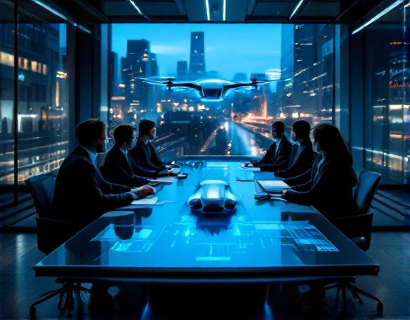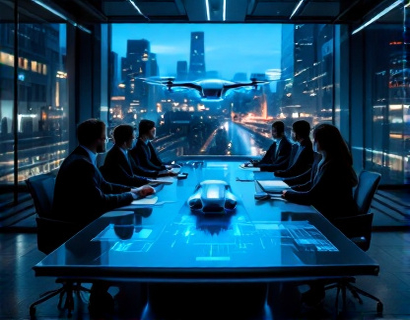AI-Powered Agent Revolutionizes Aeronautics: Streamlining Operations and Enhancing Decision-Making for Industry Professionals
The aeronautics industry, a cornerstone of global transportation and commerce, is undergoing a transformative shift with the integration of artificial intelligence (AI) technologies. This revolution is not just about automating routine tasks but about fundamentally changing how operations are managed and decisions are made. An AI-powered agent, designed with the specific challenges of the aeronautics sector in mind, is at the forefront of this change. This agent leverages advanced algorithms, machine learning, and data analytics to streamline operations, enhance decision-making, and drive innovation across the industry.
Understanding the Challenges in Aeronautics
The aeronautics industry faces a myriad of complex challenges that traditional methods often struggle to address efficiently. These challenges include managing vast amounts of data from various sources, ensuring real-time decision-making, optimizing flight schedules and routes, maintaining stringent safety standards, and adapting to rapidly changing market conditions. The industry's global nature adds another layer of complexity, requiring coordination across multiple jurisdictions and regulatory frameworks. In this context, the introduction of an AI-powered agent offers a promising solution, capable of handling these challenges with precision and efficiency.
Streamlining Operations with AI
One of the primary ways an AI-powered agent revolutionizes aeronautics is by streamlining operations. Traditional operational workflows are often fragmented and manual, leading to inefficiencies and delays. The AI agent can integrate data from various systems such as flight management, maintenance records, and customer service platforms, creating a unified and real-time view of operations. This integration enables automated workflows that reduce manual intervention, minimize human error, and accelerate process execution.
For instance, the agent can automatically generate and manage flight schedules by analyzing real-time data on weather conditions, air traffic, and aircraft availability. This not only optimizes flight paths to reduce fuel consumption and travel time but also ensures compliance with air traffic regulations. Additionally, the agent can monitor maintenance schedules and predict potential equipment failures, allowing for proactive maintenance that minimizes downtime and extends the lifespan of aircraft components.
Enhancing Decision-Making with Data Analytics
Decision-making in the aeronautics industry is critical and often based on complex, data-driven insights. An AI-powered agent excels in this area by providing advanced data analytics capabilities. The agent can process and analyze vast datasets, identifying patterns and trends that human analysts might miss. This capability is particularly valuable in areas such as market analysis, risk assessment, and strategic planning.
For example, the agent can analyze historical flight data to predict future demand for certain routes, helping airlines adjust their fleet sizes and route offerings accordingly. In risk management, the agent can monitor real-time data from multiple sources to identify potential safety hazards or operational risks, alerting decision-makers to take preventive actions. This proactive approach to decision-making not only enhances safety but also improves operational efficiency and reduces costs.
Improving Customer Experience
The customer experience is a crucial aspect of the aeronautics industry, and an AI-powered agent can significantly enhance this area. By analyzing customer data and feedback, the agent can provide personalized recommendations and services, from tailored flight offers to seamless check-in and boarding processes. The agent can also predict and address customer concerns before they escalate, improving overall satisfaction and loyalty.
Moreover, the agent can optimize airport operations by managing passenger flows, reducing congestion at check-in counters and security screening areas, and providing real-time updates on flight statuses. This not only enhances the passenger experience but also improves the efficiency of airport operations, reducing delays and increasing throughput.
Ensuring Safety and Compliance
Safety and compliance are non-negotiable in the aeronautics industry, and an AI-powered agent plays a vital role in maintaining these standards. The agent can continuously monitor operational data to detect anomalies and potential safety issues, triggering immediate alerts and corrective actions. This real-time monitoring is crucial for preventing accidents and ensuring the safety of passengers and crew.
Additionally, the agent can help airlines stay compliant with evolving regulatory requirements by tracking changes in regulations and ensuring that all operational procedures are up to date. The agent can also assist in conducting audits and reporting, streamlining these processes and reducing the administrative burden on compliance teams.
Driving Innovation and Competitive Advantage
The integration of AI in the aeronautics industry is not just about improving existing processes but also about driving innovation. An AI-powered agent can facilitate the development of new services and business models, giving industry professionals a competitive edge. For example, the agent can analyze market trends and customer preferences to identify opportunities for new routes, services, or partnerships.
Furthermore, the agent can support research and development efforts by providing insights from large datasets, accelerating the innovation cycle. This capability is particularly valuable for aircraft manufacturers and technology providers looking to develop next-generation solutions. By leveraging AI-driven insights, these companies can design more efficient, safer, and environmentally friendly aircraft and systems.
Case Studies and Real-World Applications
Several aeronautics companies have already begun to implement AI-powered agents with notable success. One major airline used an AI agent to optimize its flight scheduling and maintenance processes, resulting in a 15% reduction in operational costs and a significant improvement in on-time performance. Another regional airline implemented an AI-powered customer service agent, which led to a 20% increase in customer satisfaction scores and a reduction in support ticket resolution times.
In the aviation manufacturing sector, a leading aircraft producer integrated an AI agent into its design and production workflows, reducing development time by 10% and improving quality control. These case studies demonstrate the tangible benefits of AI in the aeronautics industry, from cost savings and efficiency gains to enhanced customer experiences and innovation.
Challenges and Considerations
While the benefits of AI-powered agents in aeronautics are clear, there are also challenges and considerations that need to be addressed. One major concern is the integration of AI systems with existing infrastructure, which can be complex and resource-intensive. Ensuring data security and privacy is another critical aspect, given the sensitive nature of aeronautics data. Additionally, there is a need for robust regulatory frameworks to govern the use of AI in the industry, ensuring that it is deployed responsibly and ethically.
To overcome these challenges, collaboration between industry stakeholders, technology providers, and regulatory bodies is essential. Continuous investment in research and development, along with a focus on scalable and flexible AI solutions, will help address these issues and unlock the full potential of AI in aeronautics.
Conclusion
The integration of AI-powered agents in the aeronautics industry represents a significant leap forward in operational efficiency, decision-making, and innovation. By addressing the unique challenges of the sector, these agents are transforming how airlines, manufacturers, and other industry professionals operate. As the aeronautics industry continues to evolve, the role of AI will become increasingly pivotal, driving the next wave of advancements and setting new standards for excellence.










































